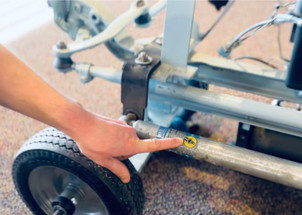
What is a Steering Stabilizer?
Steering Stabilizers vs. Steering Control:
- Understanding the Key Differences -
If you own a motorhome, you know that steering, ride quality, and overall handling are crucial in your driving experience. Recently, we compared the Safe-T-Plus Steering Control and a Bilstein Steering Stabilizer, both commonly found on motorhomes, including those equipped with the J-Ride package on Jayco and Entegra F-53 chassis.
While our previous videos on this topic were well received, we also got thoughtful questions and critiques. So, in this blog, we will take a deeper dive into the subject, clarify some misconceptions, and give you a clear understanding of how these products work, their differences, and which one might be right for you.
What is a Steering Stabilizer?
A steering stabilizer (or damper), like the Bilstein unit in our test, is designed to reduce vibrations and absorb shocks from the road. It helps to minimize bump steer and road feedback, providing a smoother ride. However, it does not actively return the steering to center after a turn.
Gas Pressure: Does It Affect Steering?
One of the biggest criticisms of our previous comparison was regarding gas pressure inside the Bilstein unit. Some argued that the gas charge doesn’t influence the performance of the damper. And to an extent, that is true—in a suspension application.
For example, a Bilstein suspension shock absorber has gas pressure to keep the internal valve stack engaged with the oil, ensuring smooth damping action. However, this gas pressure is relatively negligible compared to the damping forces controlling ride movement.
But here’s where things get interesting:
👉 Suspension damping and steering control are two completely different applications.
👉 A motorhome’s suspension requires significant force to change ride height.
👉 Steering, however, requires much less force to be influenced.
Even a slight pressure differential in a steering stabilizer can push the steering off-center, which leads us to the next important point…
What is a Steering Control Device?
Unlike a basic damper, the Safe-T-Plus Steering Control is specifically designed to center the steering and keep the vehicle going straight. It combines damping with a built-in centering force, which actively works to counteract the effects of road crown, crosswinds, and sudden steering inputs (like a front tire blowout).
How Does Safe-T-Plus Work?
When we installed the Safe-T-Plus unit on our demo axle, we could see the difference immediately:
✅ It contains internal springs that actively push the steering back to center.
✅ Provides about 230 lbs of centering force right off-center, ensuring quicker realignment.
✅ Reduces driver fatigue by keeping the RV tracking straight with minimal corrections.
✅ Enhances control in the event of a blowout or sudden steering movement.
This is not just a stabilizer—it’s a true steering control device.
Why Does This Matter?
1. Can a Steering Control Device Mask Other Issues?
Some people argue that adding a steering control device covers up other underlying issues. There’s truth in that, which is why we always recommend doing a test drive and inspection before installing a Safe-T-Plus. If the coach has not recently been aligned and there signs of uneven tire wear, it is wise to perform an alignment before installing a Safe-T-Plus. Also, if there are mechanical problems like worn bushings or loose components, those should be fixed first.
However, even with perfect alignment, some motorhomes still struggle with steering stability—especially on Ford F-53 and Freightliner XC chassis. These platforms have limitations in how much caster (the key factor for self-centering) can be added. A Safe-T-Plus can correct this and improve tracking.
2. What About Semi-Trucks? Don’t They Track Straight Without a Stabilizer?
Some comments suggested that semi-trucks don’t need steering stabilizers, so why should RVs?
Well, here’s an interesting fact:
The Safe-T-Plus Steering Control was invented in the 1980s by T. L. Sexton, a trucker who had lost too many friends in front tire blowout accidents. He designed it to help maintain control in emergencies, and over time, it became a favorite among both truckers and RV owners for its safety and drivability benefits.
Final Thoughts: Which One Should You Choose?
-
- If you’re looking for basic damping and shock absorption, a Bilstein steering stabilizer will do the job.
- If you need true steering control, self-centering, and improved safety, the Safe-T-Plus Steering Control is the better choice.
We hope this detailed breakdown helps answer some of the questions in our previous discussions.
